The Palais des Tuileries (Tuileries Palace) is the former residence of the Kings and Queens of France. One of the most beautiful palaces in France, it was destroyed by fire in 1871 during the Paris Commune. The monument was an integral part of Paris’ Historical Axis. Today its gardens are the oldest in Paris, known as the Jardin des Tuileries.
Where exactly did the Palais des Tuileries stand?
The Palais des Tuileries was located in the First Arrondissement in the precinct of the Louvre.
The royal residence had an impressive 328 metre-long façade and used to stand between the Flore and Marsan Pavilions, now connected to the Louvre Palace.
![Map of Louvre and Tuileries © - licence [CC BY-SA 3.0] from Wikimedia Commons](https://frenchmoments.eu/wp-content/uploads/2012/11/Map-of-Louvre-and-Tuileries-©-licence-CC-BY-SA-3.0-from-Wikimedia-Commons.png)
The Tuileries Palace once closed the perspective between the Louvre and the Arc de Triomphe. Or, to be exact, the palace was in fact the starting point of Paris’ Historical Axis.
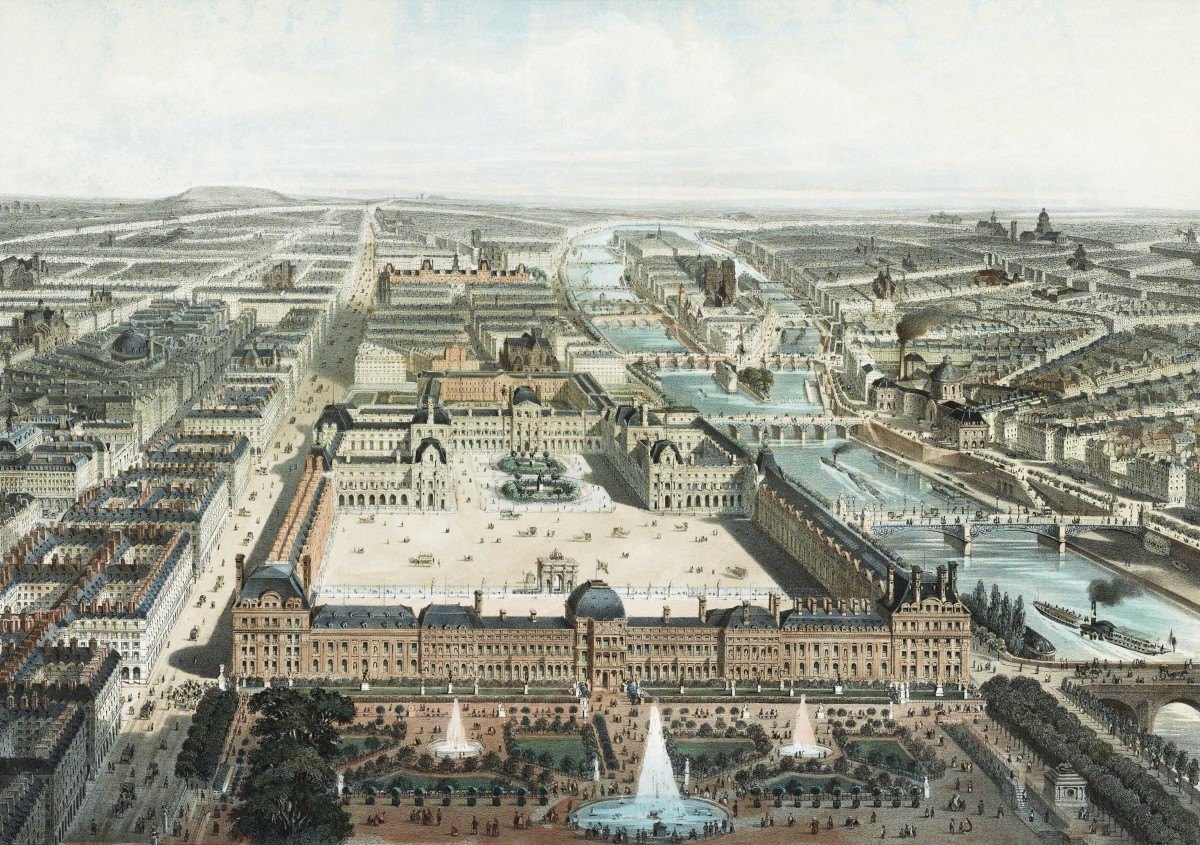
One day I entered the Louvre to find the exact window where this view was taken:

It took me quite a while to find the exact window… but I did it!
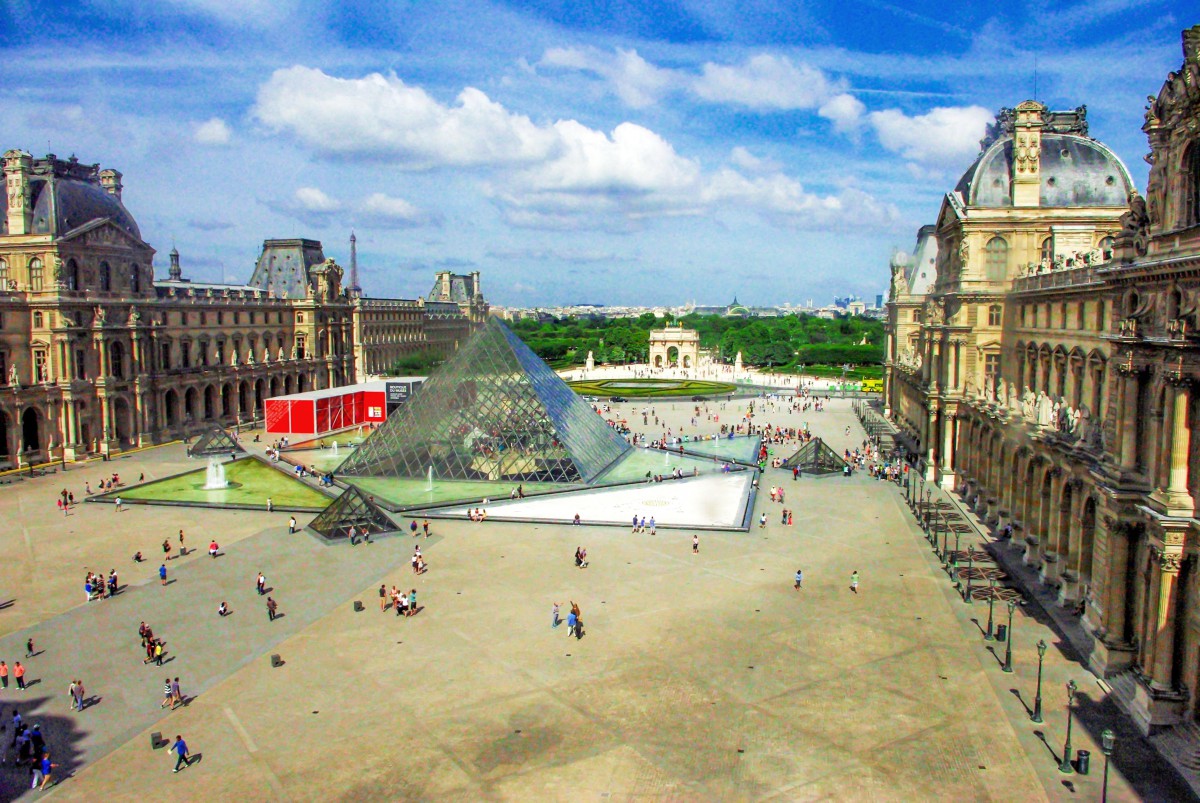
The grassy bit that you see in the old photo does not exist anymore. This is where the famous glass pyramid now stands. However, the triumphal arch of the Carrousel still exists today.
And thanks to Photoshop, I recreated the lost Palais des Tuileries which once closed the Louvre courtyard. This is to give you an idea of the location of the palace:
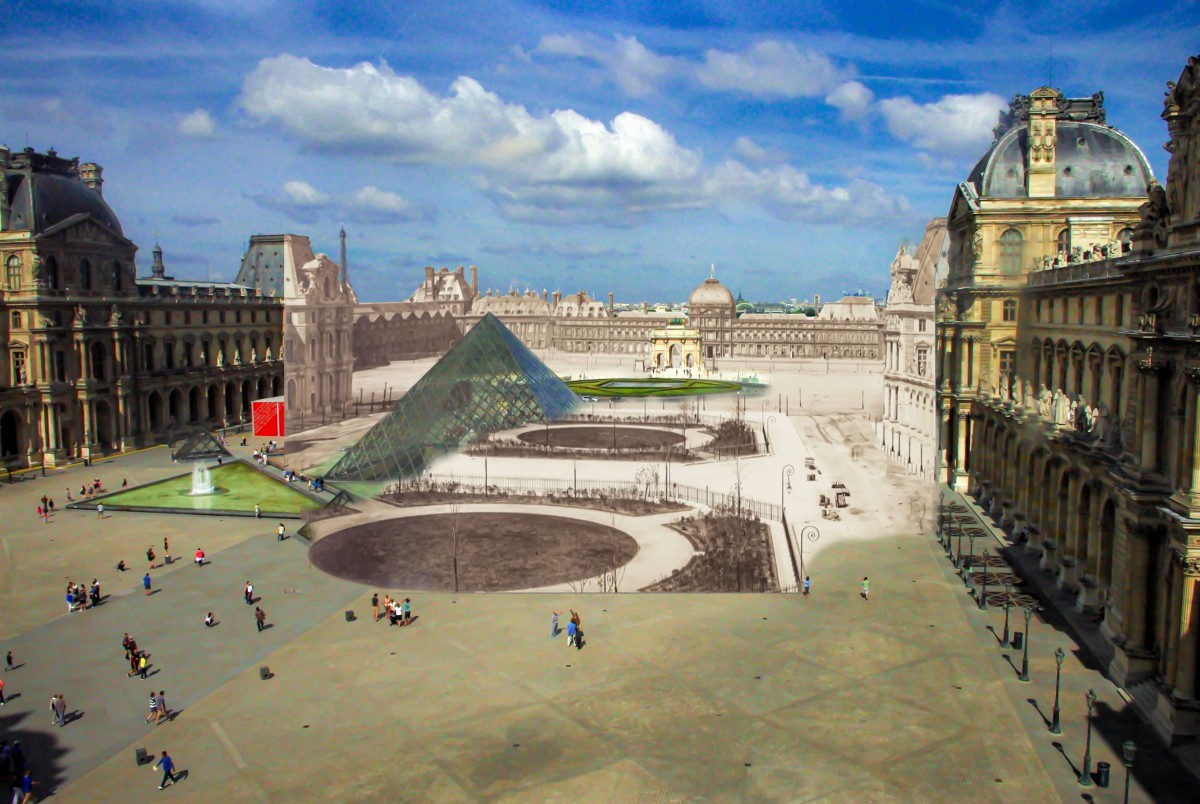
When was the Tuileries Palace built?
The Palais des Tuileries is not as old as the Louvre which dates back to the Middle Ages.
Queen Catherine de Medici commissioned from architect Philibert de l’Orme a royal palace in 1564 on the site of a tile factory (hence the French name ‘Tuilerie’ deriving from ‘tuile’ – tile). But she never resided in it as she was a very superstitious woman.
Legend has it that her astrologer Ruggieri once predicted she would die “near Saint-Germain”. However, the palace stood in the vicinity of the church of Saint-Germain-l’Auxerrois. As cautious as she was, the Queen preferred to live in a new-built townhouse: the Hôtel de Soissons (on the site of the Bourse de Commerce).
Then, king Henry IV (1553–1610) had the palace enlarged to the south. There it reached the Grande Galerie, a long gallery parallel to the River Seine, which ran all the way to the Louvre Palace.
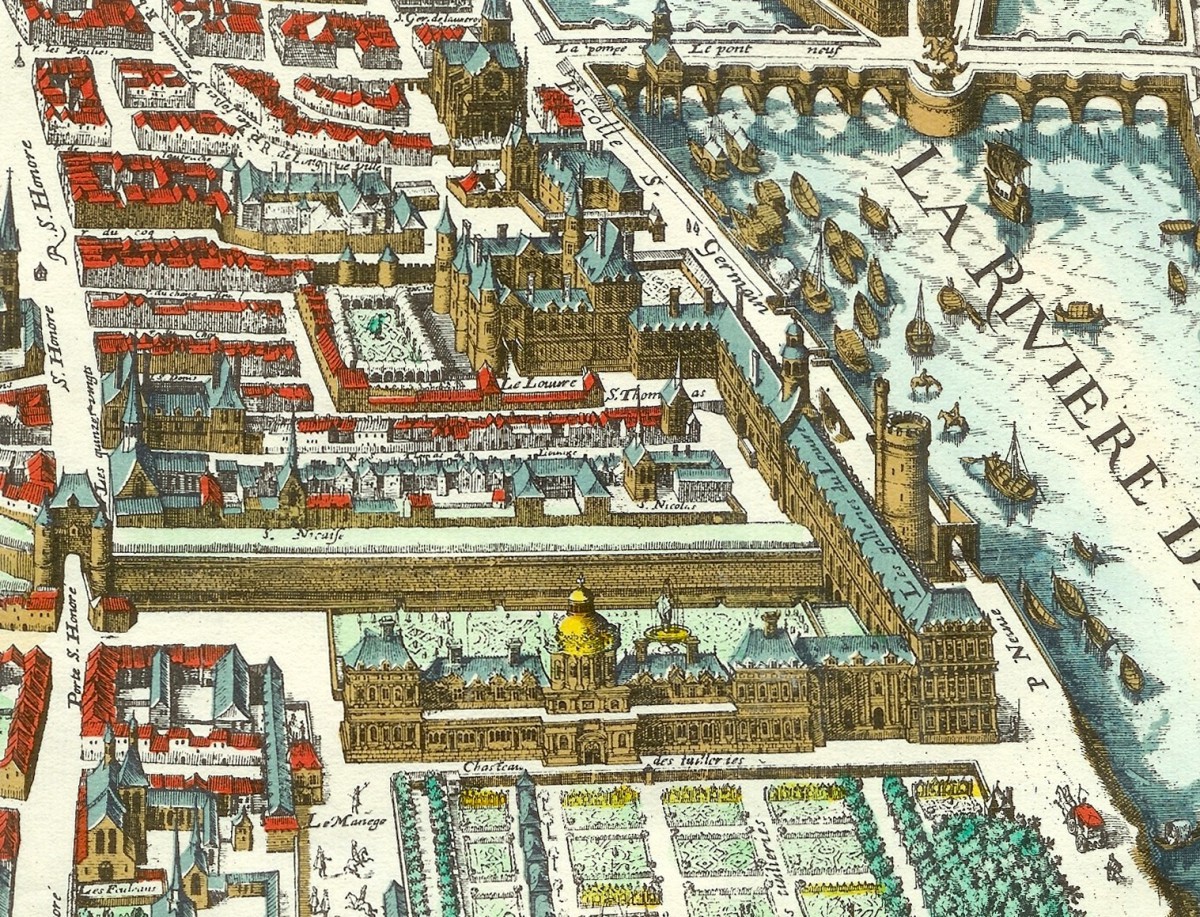
The Tuileries under Louis XIV
The young Louis XIV lived there until the Fronde rebellion. From 1667 to 1672 the king and its court set up at the Tuileries before moving permanently to Versailles.
Major transformations took place in the Palais des Tuileries under the reign of the Sun King. Louis XIV appointed architect Louis Le Vau to do the work.
From 1664 to 1666 the French architect and his assistant François d’Orbay renovated the interiors and added a rectangular dome on top of the central pavilion – the “pavillon de l’horloge”.
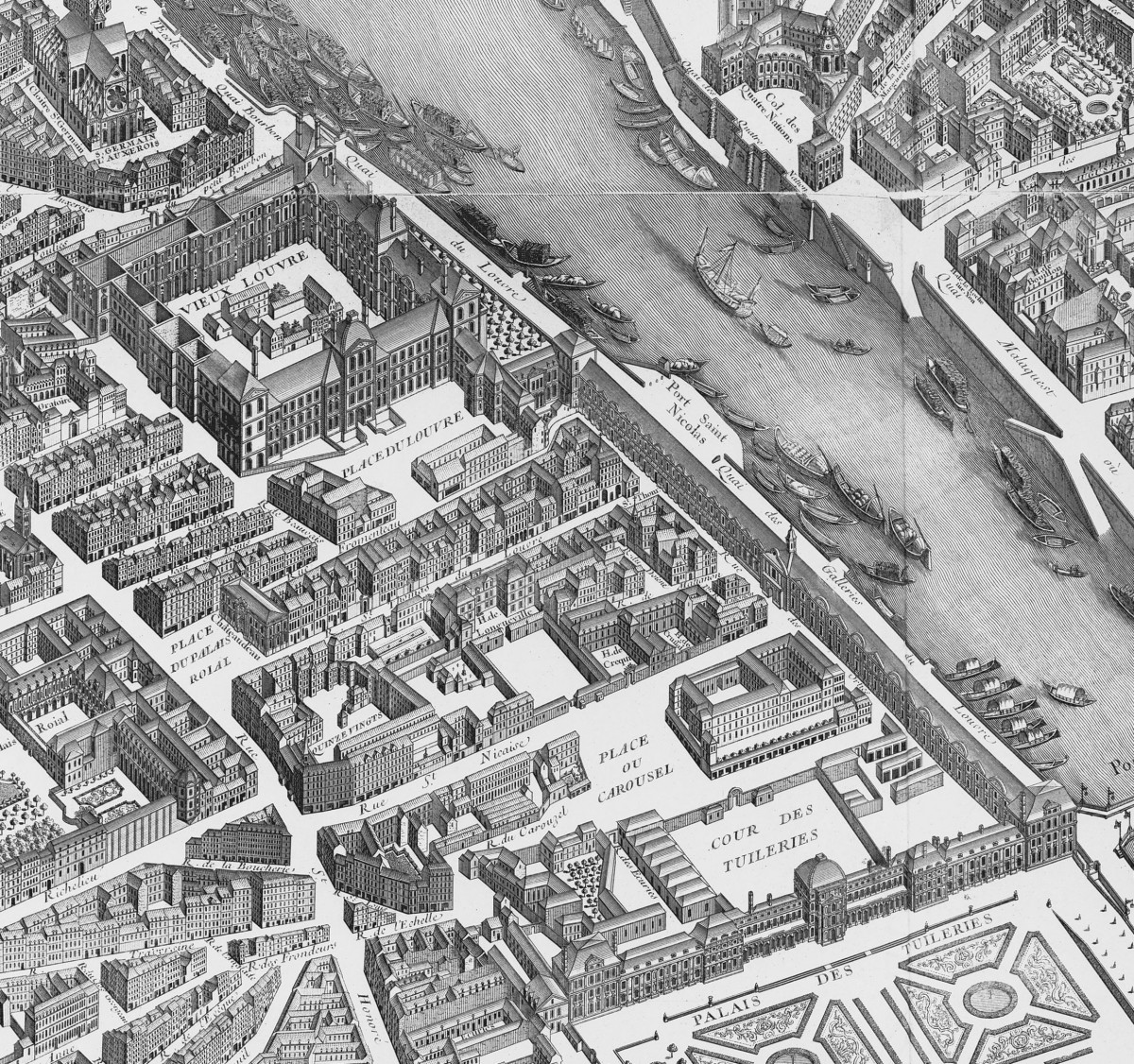
At the same time, the garden of the Tuileries Palace underwent a major redevelopment. The king commissioned his best gardener, André Le Nôtre, to redesign the Tuileries Garden.
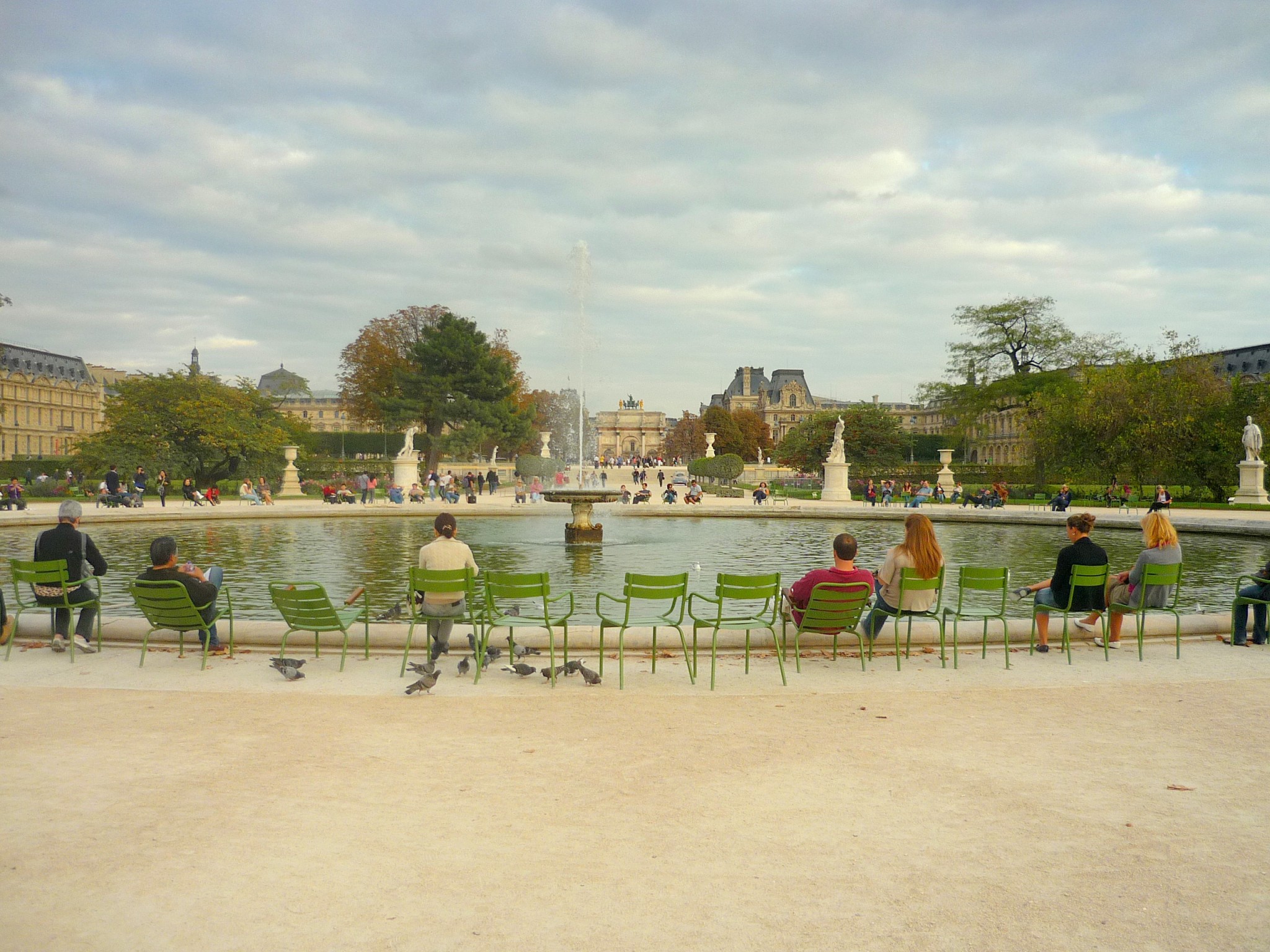
The Tuileries Palace during the French Revolution
In 1789, the events of the French Revolution unfolded very rapidly.
On 14 July, the Storming of the Bastille took place in Paris, when insurgents dismantled the fortress, a symbol of royal power.
On 6 October, the Revolutionaries forced king Louis XVI and his family to leave Versailles for the Tuileries. It was easier to keep them under surveillance at the palace which became the official residence of the king of France.
Less than 2 years later, on 20 June 1791, the royal family tried to escape France. They were captured at Varennes, Lorraine, and brought back to the Tuileries.
Then, on 10 August 1792, an armed mob stormed the palace and killed the Swiss Guard. The royal family fled through the Tuileries garden to find refuge at the Legislative Assembly.
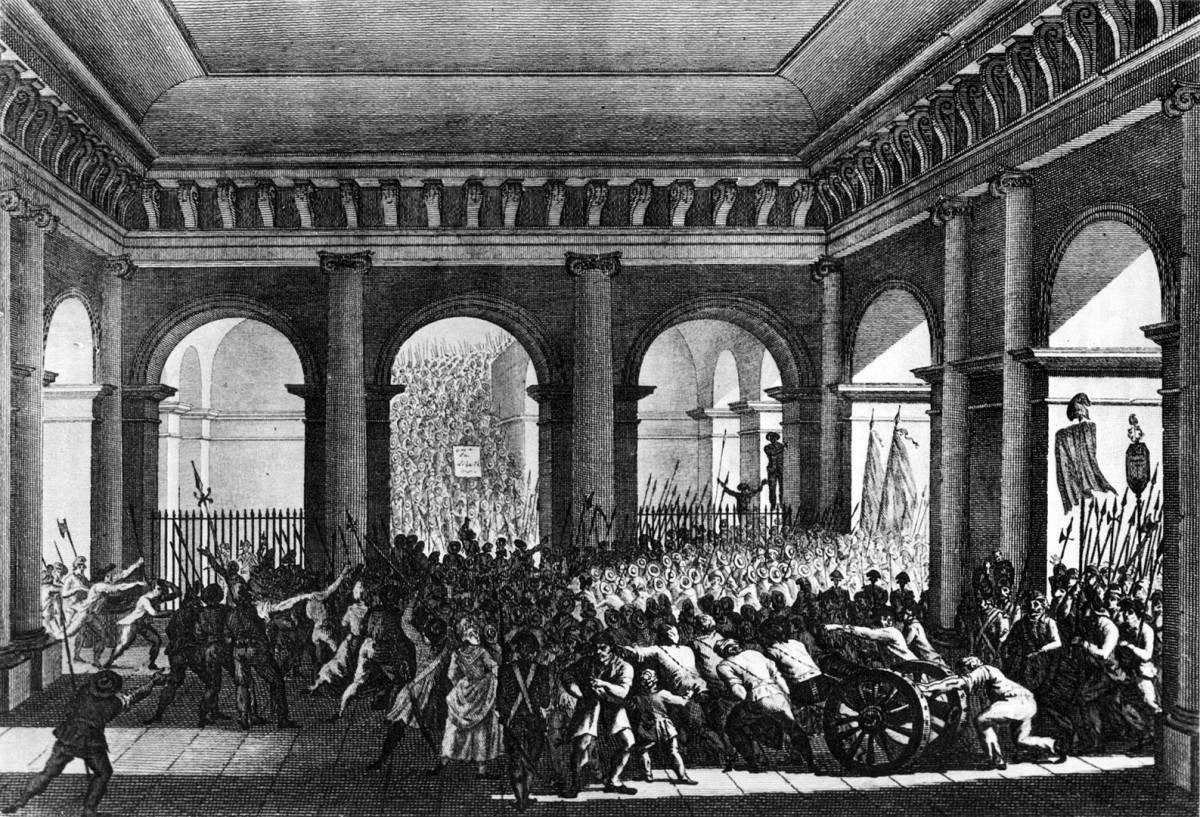
The Tuileries, Seat of the French Empire
After the French Revolution, Napoleon Bonaparte made the Tuileries the centre of his imperial power. In 1808, the emperor started the construction of the northern gallery that would eventually reach the Louvre. In doing so, the completed and monumental complex of the Louvre-Tuileries enclosed a vast square – or esplanade.
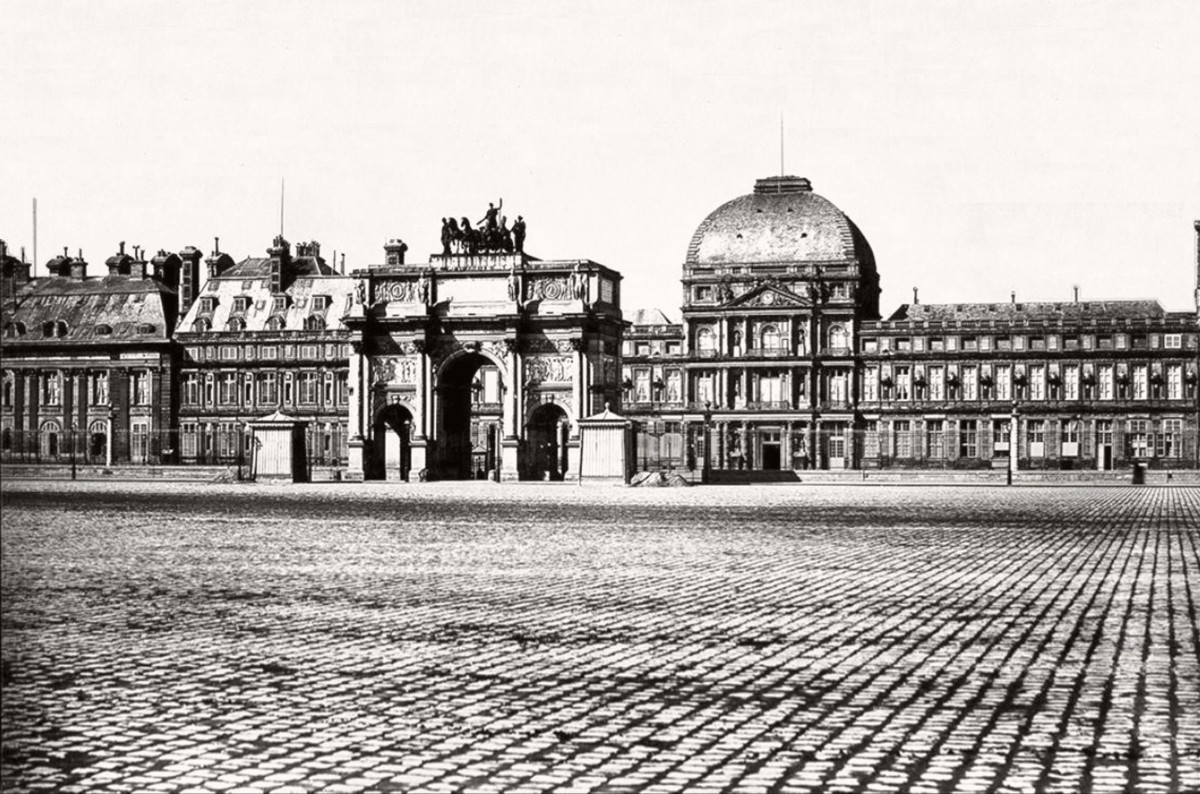
The façade that gave onto the garden was ornate with a splendid staircase:
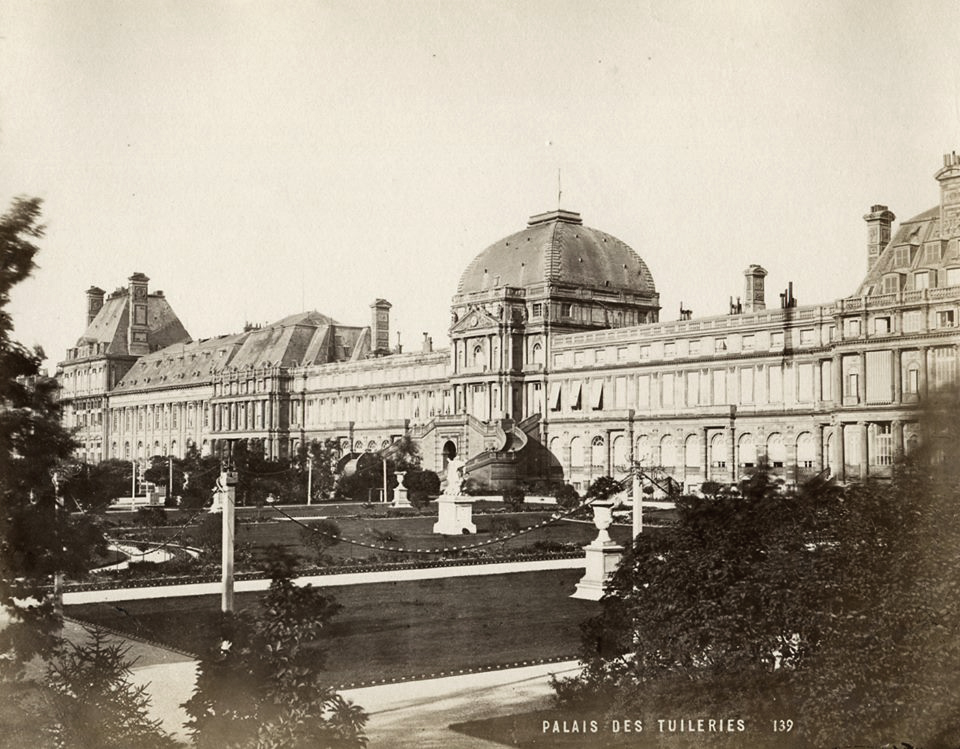
His nephew, Napoleon III also made the Tuileries the official seat of the Second Empire. He refurbished and redecorated the interiors lavishly.
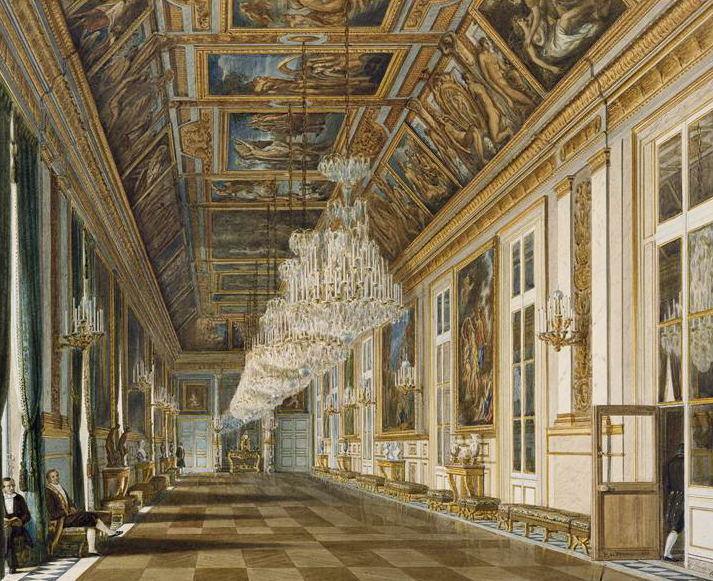
Not only paintings but old photos give us a glimpse of what the interior used to look like:

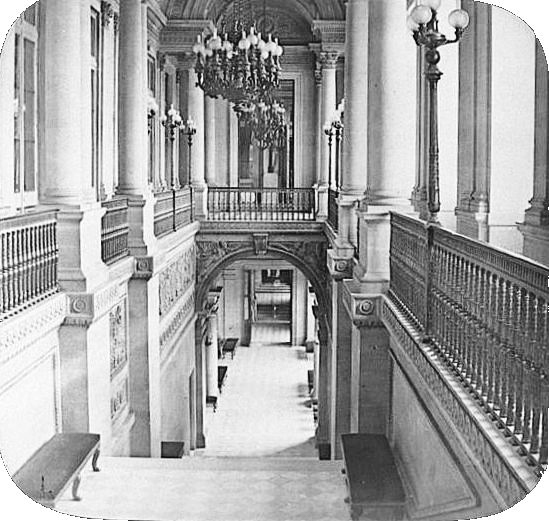
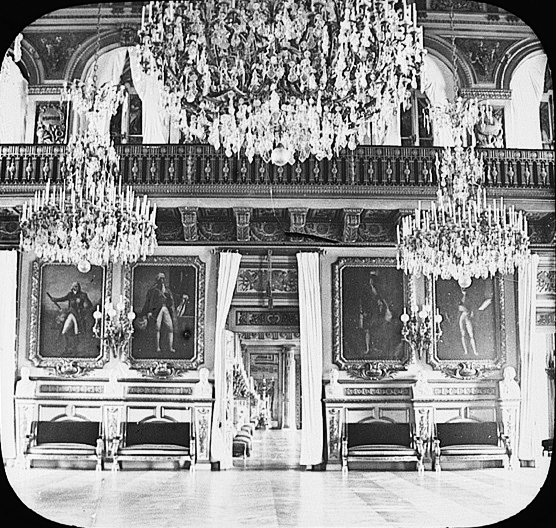
When and why did the Tuileries Palace disappear?
23 May 1871, the day when the historic palace met its fate.
It was 150 years ago (or it will be in 2021!)
The Paris Commune
The Paris Commune was a radical socialist and revolutionary government that ruled Paris in the aftermath of the Franco-Prussian war, from 18 March to 28 May 1871.
The radical council of Paris refused the authority of the provisional French government of Thiers that had set up its headquarters in Versailles.
The Paris Commune governed the French capital for two months only. It ended when the French Armed Forces under MacMahon besieged the city during “La semaine sanglante” (“The Bloody Week”) from 21 to 28 May 1871.
The sabotage of the Tuileries
In the middle of the military action, on 23 May at 7 pm, 12 men under the orders of a Paris Commune commander set the Tuileries on fire. To achieve the goals they used petroleum, liquid tar and turpentine.
Explosives placed in the central pavilion blew up the fabulous and iconic dome.
The fire would last 48 hours and destroyed most of the edifice. It also damaged the neighbouring Louvre which miraculously escaped the same fate. The fire did not touch the Arc de Triomphe du Carrousel.
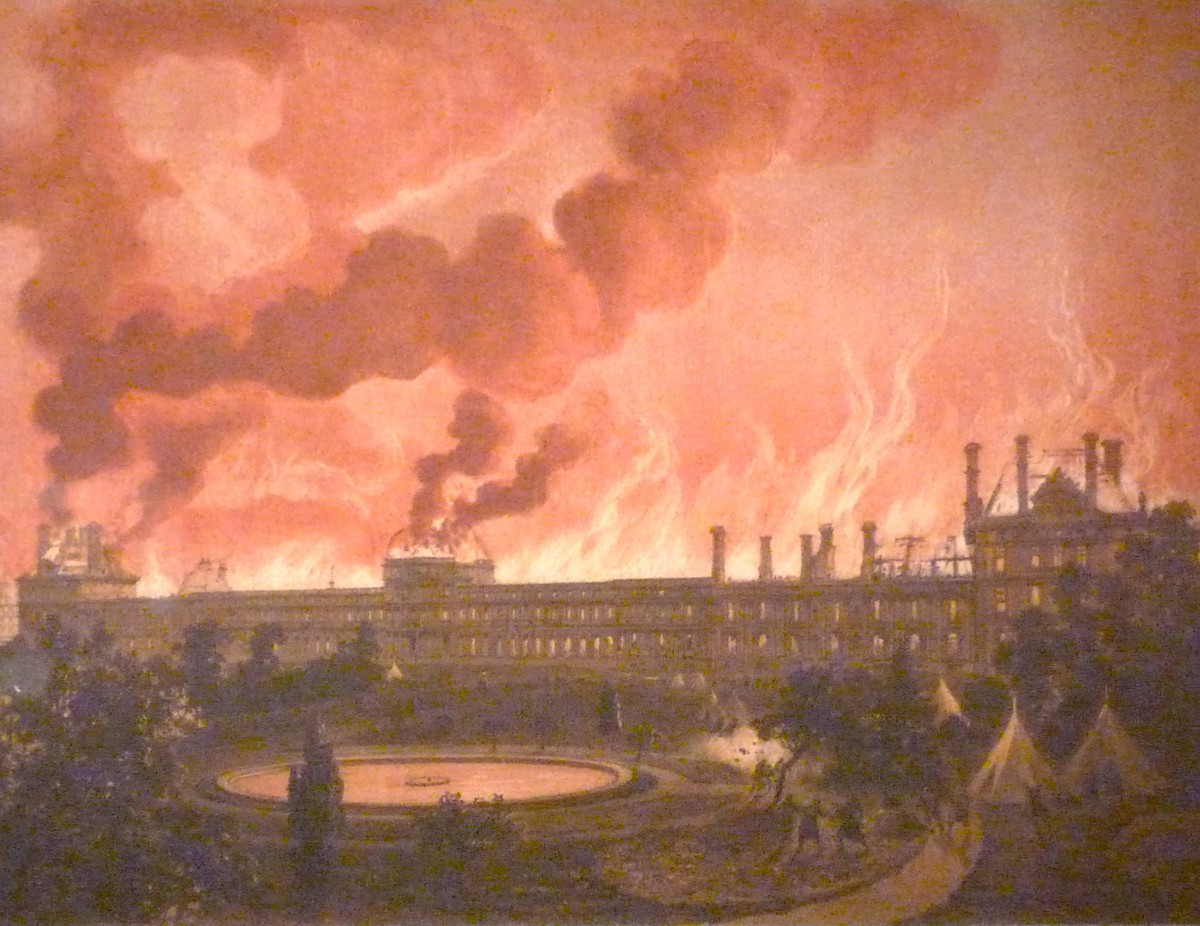
Fortunately, the palace was empty during the fire as its furniture and works of art were stored in a safe place during the Franco-Prussian war!
On 25 May the Paris fire brigades and the 26th battalions of the Chasseurs d’Afrique put an end to the fire.
A Palace in ruins
The ruins of the Palais des Tuileries stood there, miserably for a whole decade. 11 years to be exact.
Many photos of the time show the dreadful ruins closing the perspective of the Louvre.
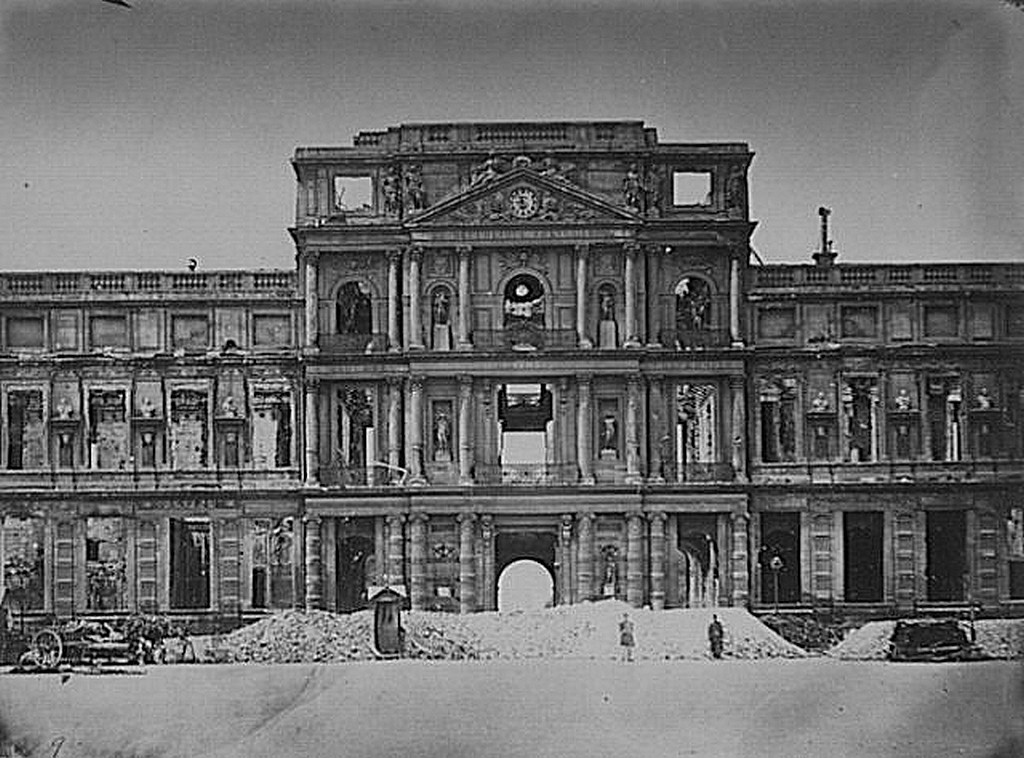
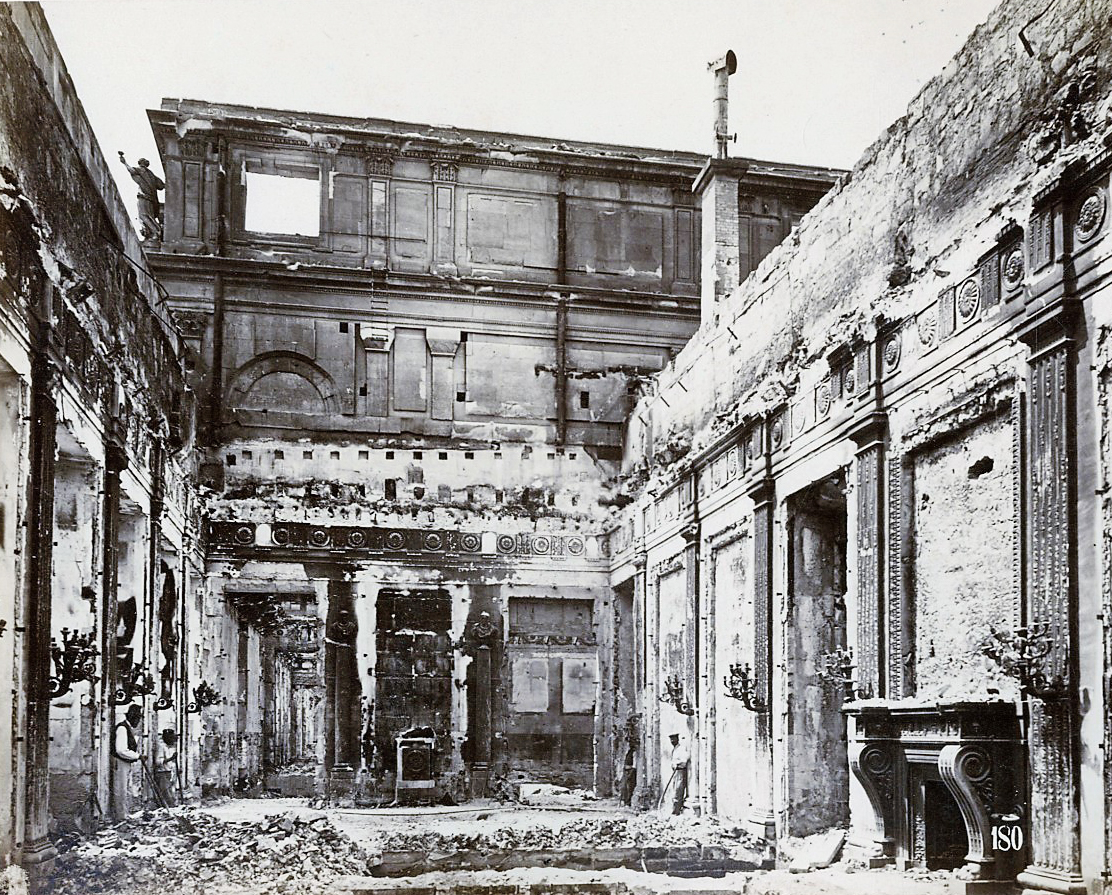
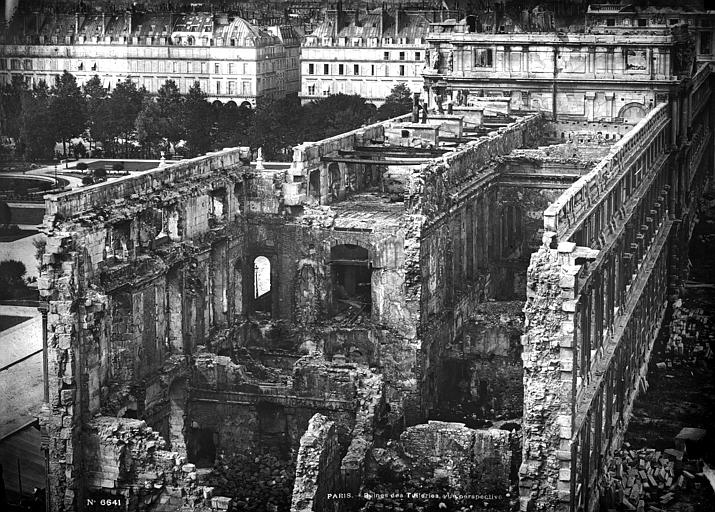
The roofs and the interiors had been completely destroyed by the blaze. However, the walls of the palace remained intact. The photo below does show the relatively good state of the walls after the fire:
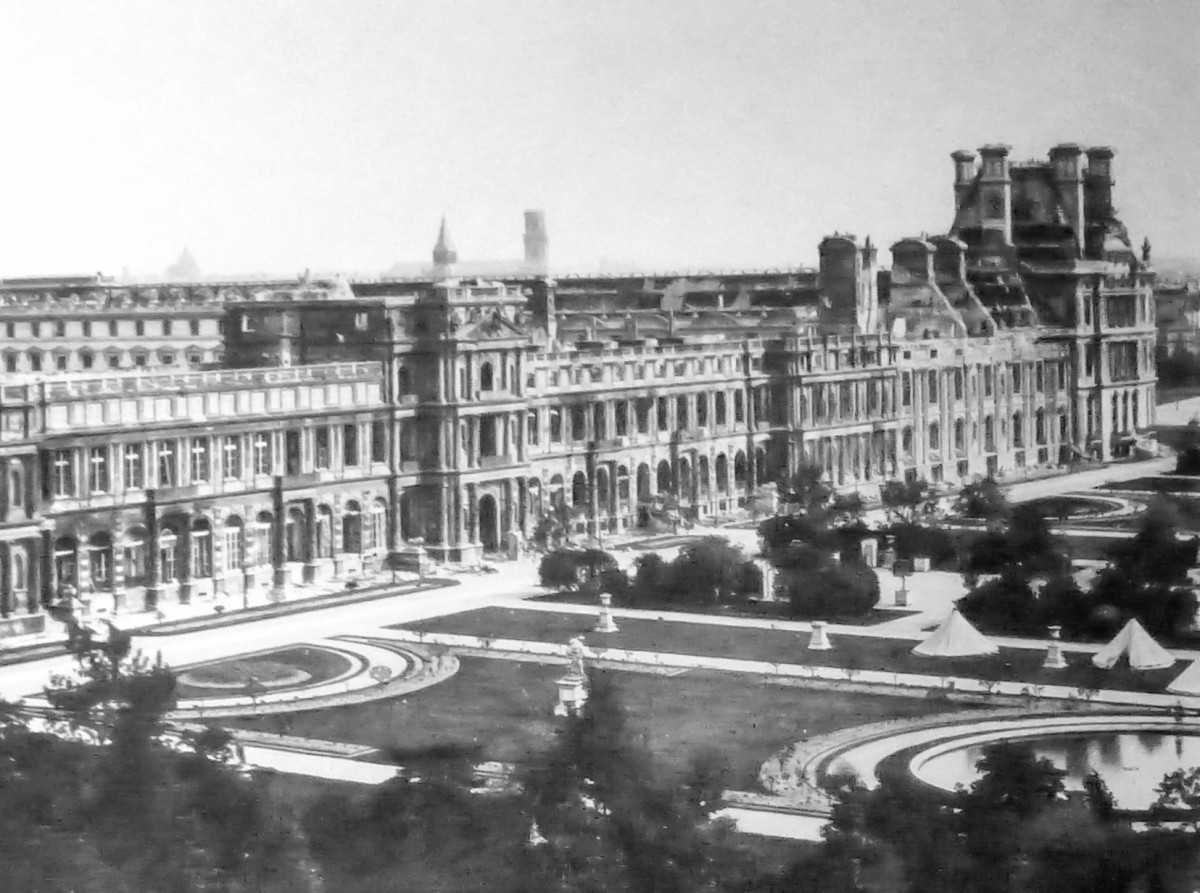
In fact, restoration was possible since other monuments destroyed by fire in 1871 such as the Paris City-Hall or sections of the Louvre had been rebuilt.
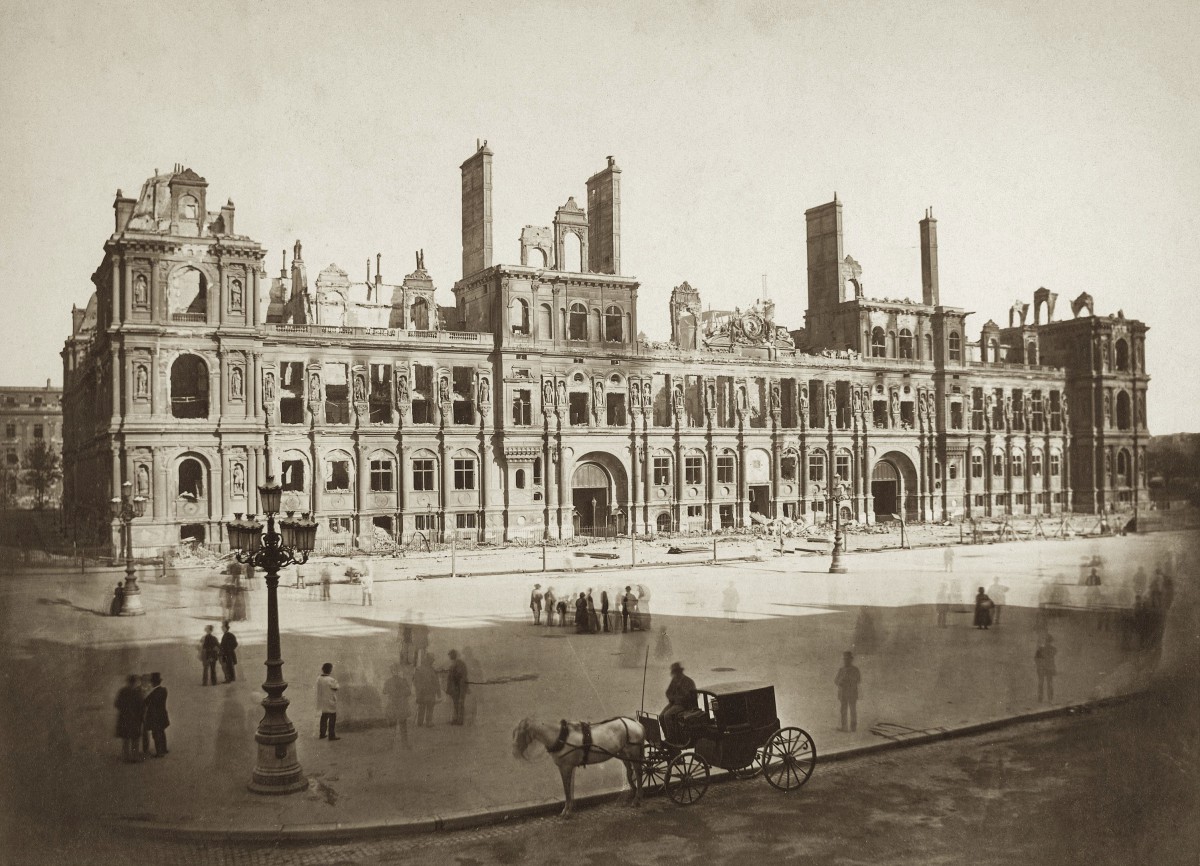
The Third Republic was hesitant. After all, the Tuileries was freshly related to the former imperial regimes of the two Napoleons.
After years of procrastination on the rebuilding, the National Assembly finally voted on 21 March 1882 to clear away the ruins. A number of influential people protested against such a decision: Baron Haussmann, architect Viollet le Duc, and other French personalities.
According to the National Committee for the Reconstruction of the Tuileries, “no law decided to destroy the Tuileries. On the contrary, the Government committed solemnly in 1882 to reconstruct the palace. But it did not keep its promise”.
It took several months to complete the demolition works. It started in February 1883 and ended on 30 September 1883.
A fatal consequence for the Historical Axis
Prior to its destruction, the Palace of the Tuileries played a full role along the Historical Axis as it was its real starting point.
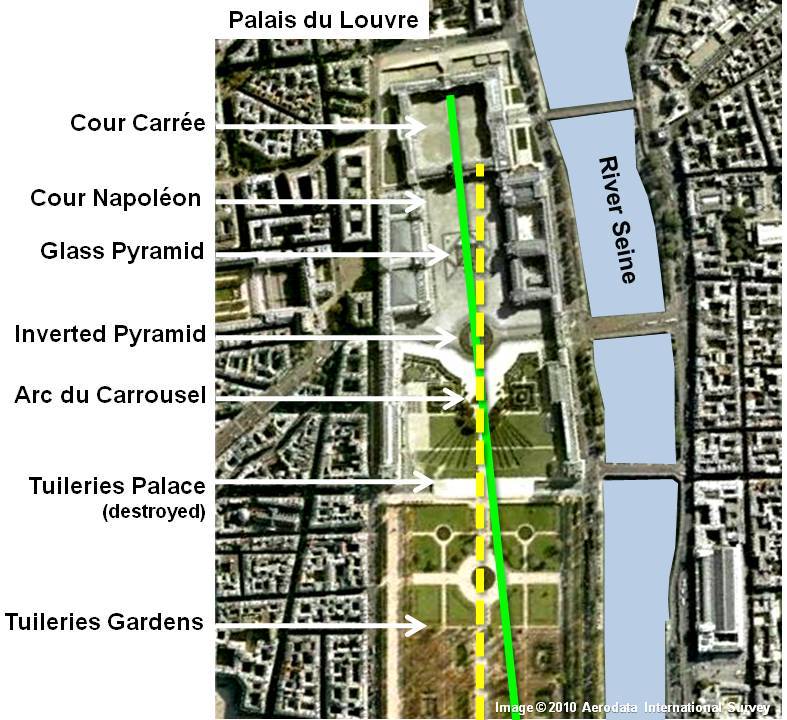
The absence of the original landmark moved the visual start of the axis back to the Cour Napoléon and its glass pyramid to reveal a deviation of the axis to visitors. In fact, garden architect Le Nôtre planned the axis to run from the Tuileries and its gardens in the 17th century – and not from the Louvre.
Will the Palais des Tuileries ever be rebuilt?
Since it disappeared from the Paris famous landmarks, the question of rebuilding the Tuileries palace has been raised from time to time.
Rumour has it that Charles de Gaulle supported the reconstruction of the palace, saying that it would “make a jewel of the centre of Paris”. The French president was contemplating changing the Seat of the French presidency from the Elysée Palace to the restored Tuileries Palace.
A debate on the reconstruction initiated in the 2000s
In the 2000s there has been a serious debate on rebuilding the Palais des Tuileries. The National Committee for the Reconstruction of the Tuileries was working to that end. At one point the project had a serious chance of succeeding.
Many reasons could have convinced the authorities (and the French people!) of the benefit of such an operation.
- First, it would have returned the royal complex of the Louvre to its former glory, that of “Le Grand Dessein” (the “Great Design”) and allowed more exhibition facilities for the rich collections of the museum.
- Secondly, since all the furniture and paintings which used to decorate the inside of the Palace still exist today (they were stored in a safe place during the Franco-Prussian War before the 1871 fire), it would be quite simple to return them to their initial location.
But with the global financial crisis in the 2010s followed by the pandemic crisis in 2020, it is very unlikely that this project will see the light of day in the near future. Without forgetting the great fire of Notre-Dame – another great Parisian landmark – that still focuses attention.
If you wish to know more about the reconstruction of the Palais des Tuileries, visit www.tuileries.org.
The Palais des Tuileries – a ghost palace
When the site of the Palais des Tuileries was cleared in 1883, the State kept a number of pieces from the façades as souvenirs.
Demolition contractor Achille Picard was chosen to do clear the place. He sold bits of stone and marble that were scattered around the world. Actually, a similar trade took place with the fall of the Berlin Wall…
Where to find pieces of the Tuileries in Paris
There are many souvenirs of the Tuileries Palace in Paris. You can see them on the following sites:
- Square Georges Cain, rue Payenne (3rd arrondissement). The courtyard pediment of the central pavilion and its clock. This is the most important vestiges of the Palais des Tuileries.
- Galerie du Carrousel (1st arrondissement). In the hall built under the Arc du Carrousel are statues that once decorated the pediment of the central pavilion.

- Cour Marly, Louvre (1st arrondissement). The museum’s courtyard keeps an ionic arcade and two columns from the façade (garden side).
- Tuileries Garden (1st arrondissement). Look for an arcade of the palace just under the Terrasse au bord de l’eau, between allée de Castiglione and allée de Diane.
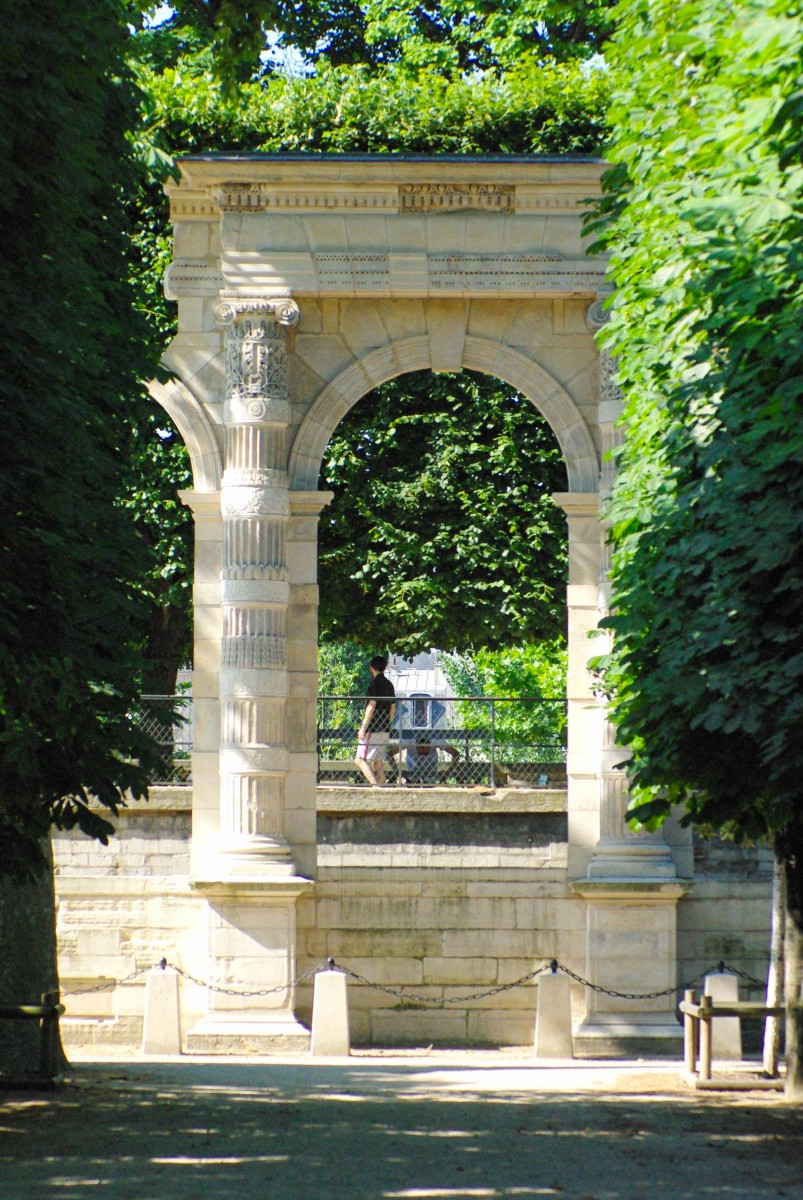
- Trocadéro Gardens (8th arrondissement). In the west part of the gardens are two remains, side by side: a door frame and a window frame.
- Other pieces are found in the Museum of Decorative Arts, École nationale supérieure des beaux-arts (ENSBA) and École spéciale d’architecture (ÉSA).
Pieces of the Tuileries across France
- In 1956, the mayor of Barentin, Normandy bought 17 columns of the palace to decorate the newly created théâtre de Verdure.
- 43 pieces of the palace are in Saint-Raphaël, French Riviera, in the gardens of the villa Magali.
- Other remains are kept in museums (Nantes, Dieppe).
- In addition, Duke Jérôme Pozzo di Borgo bought a great quantity of stones from Achille Picard. He shipped them all to Corsica where he rebuilt a pavilion of the palace in Corsica. Therefore, to a large extent, his château de la Punta near Ajaccio is a reconstruction of the Bullant Pavillon of the Tuileries. The castle suffered from a blaze in 1978 and still needs funds to restore it to its former state.
![The chateau de la Punta near Ajaccio, Corsica © Herve20000 - licence [CC BY 3.0] from Wikimedia Commons](https://frenchmoments.eu/wp-content/uploads/2012/11/Punta-Ajaccio-©-Herve20000-licence-CC-BY-3.0-from-Wikimedia-Commons.jpg)
The Tuileries across the world, from Berlin to Ecuador!
Pieces of the palace were scattered in Europe and overseas. A few locations:
- Schwanenwerder Island, Berlin, Germany. In 1882, as the National assembly voted for the removal of the palace ruins (1882), Wilhelm Wessel purchased the Schwanenwerder island in southwestern Berlin. The wealthy German inventor and manufacturer of kerosene lamps acquired a Corinthian column of the palace and placed it on his island. It made it part of a mock ruin, typical of the spirit of Romanticism in late 19th-century Germany.
![Column of the Palais des Tuileries in Schwanenwerder Island © Times - Private collection - licence [CC BY-SA 3.0] from Wikimedia Commons](https://frenchmoments.eu/wp-content/uploads/2012/11/Tuileries-Schwanenwerder-©-Times-Private-collection-licence-CC-BY-SA-3.0-from-Wikimedia-Commons.jpg)
- Bordighera, Italian Riviera. The beautiful gardens of the Villa Garnier include a column from the Tuileries Palace. French architect Charles Garnier built the Villa Garnier in 1871-1873 to serve as his residence.
![Column of the Palais des Tuileries in Villa Garnier, Bordighera © Bettylella - licence [CC BY-SA 4.0] from Wikimedia Commons](https://frenchmoments.eu/wp-content/uploads/2012/11/Villa-Garnier-Tuileries-Bordighera-©-Bettylella-licence-CC-BY-SA-4.0-from-Wikimedia-Commons.jpg)
- Carondelet Palace, Quito, Ecuador. Yes, this is rather surprising. But there is an explanation… The Carondelet Palace is the official residence of the President of the Republic of Ecuador. On the exterior atrium of the palace is a stone colonnade. And between the columns are wrought iron railings. Antonio Flores Jijón, an Ecuadorian representative in France bought the balustrades by order of the then President Gabriel García Moreno. Rumour has it that on his visit to Ecuador on 24 September 1964, French President Charles de Gaulle recognised the wrought-iron railings during his speech at the palace and exclaimed with great emotion: “C’est des Tuileries!” (It’s from the Tuileries!).
![The railings from the Palais des Tuileries, Carondelet Palace, Quito © H3kt0r - licence [CC BY-SA 4.0] from Wikimedia Commons](https://frenchmoments.eu/wp-content/uploads/2012/11/Exterior-galery-Palacio-de-Carondelet-Quito-©-H3kt0r-licence-CC-BY-SA-4.0-from-Wikimedia-Commons.jpg)
The shadow of the Tuileries hanging from America to Australia!
From the late 1850s, the iconic squared-dome roof of the Tuileries was imitated all over the western world, particularly in the United Kingdom, North America and Australia.
Paradoxically it had much less influence in France… and almost none in Paris!
The roof style was a symbol of cosmopolitan modernity. Hotels, banks, commercial buildings, as well as residences widely adopted its style.
Let me give you an example by going Down Under!
The Tuileries’ influence in Sydney, Australia
If you happen to be in Sydney, check out the Chief Secretary’s Building, between Circular Quay and the Royal Botanic Garden. The heritage-listed building located at 121 Macquarie Street, Sydney dates back to 1881. The state government building originally bore the name of Colonial Secretary’s building.
Overall the building is of Victorian Second Empire style (or Venetian Renaissance)… topped with a French-inspired roof!
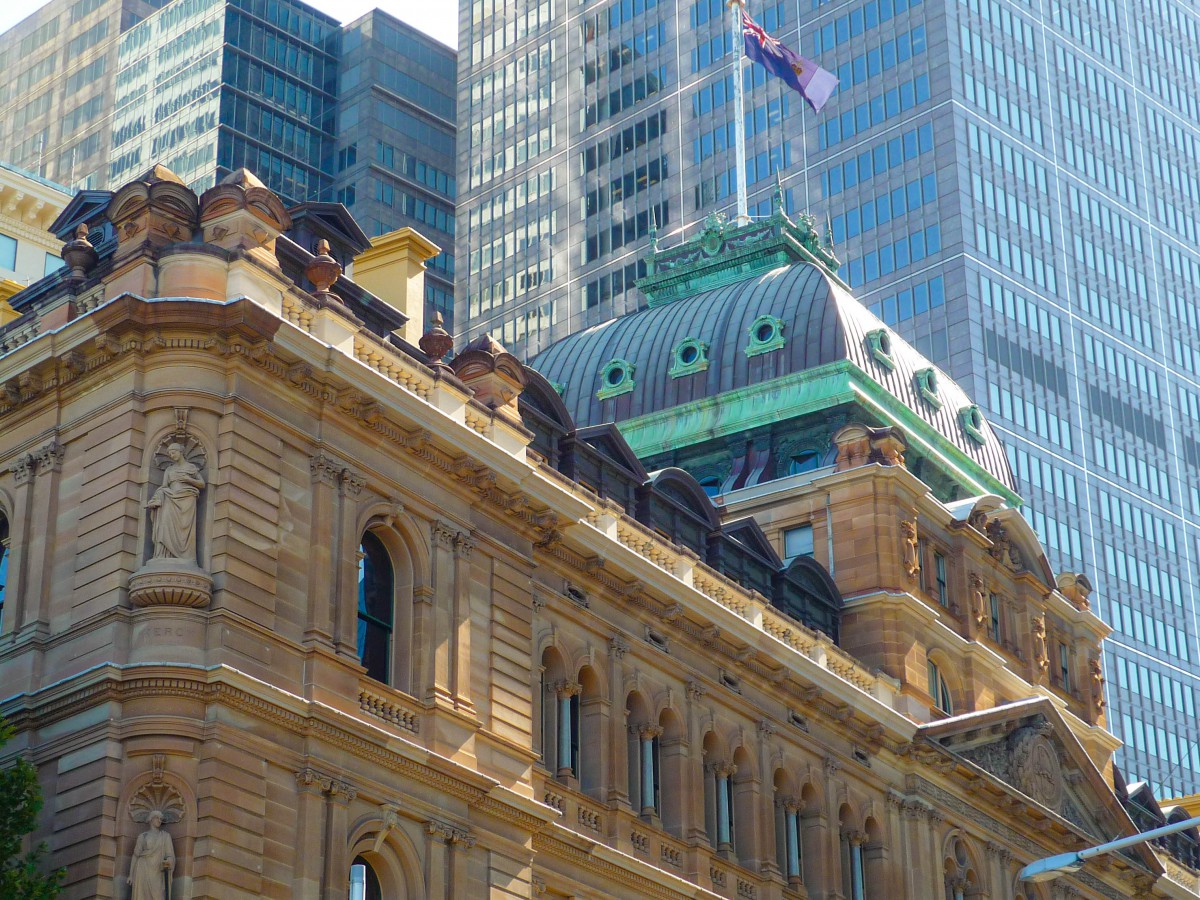
Indeed the building has a copper and slate Mansard roof and a pavilion dome added in 1893. In fact, if you look closer, you’ll notice how the central copper-clad dome is reminiscent of that of the Tuileries Palace! Fascinating isn’t it?
Sydney Town-Hall, the best French-inspired edifice in Australia!
But the most striking example in Sydney is… the Town-Hall itself!
I used to walk past it so many times where we resided in Sydney. I even participated in a school event inside when I was a French teacher.
In fact, the Sydney Town-Hall (opened in 1889) was inspired by the French Second Empire style. And more particularly by the neo-Renaissance building of the Paris City-Hall.
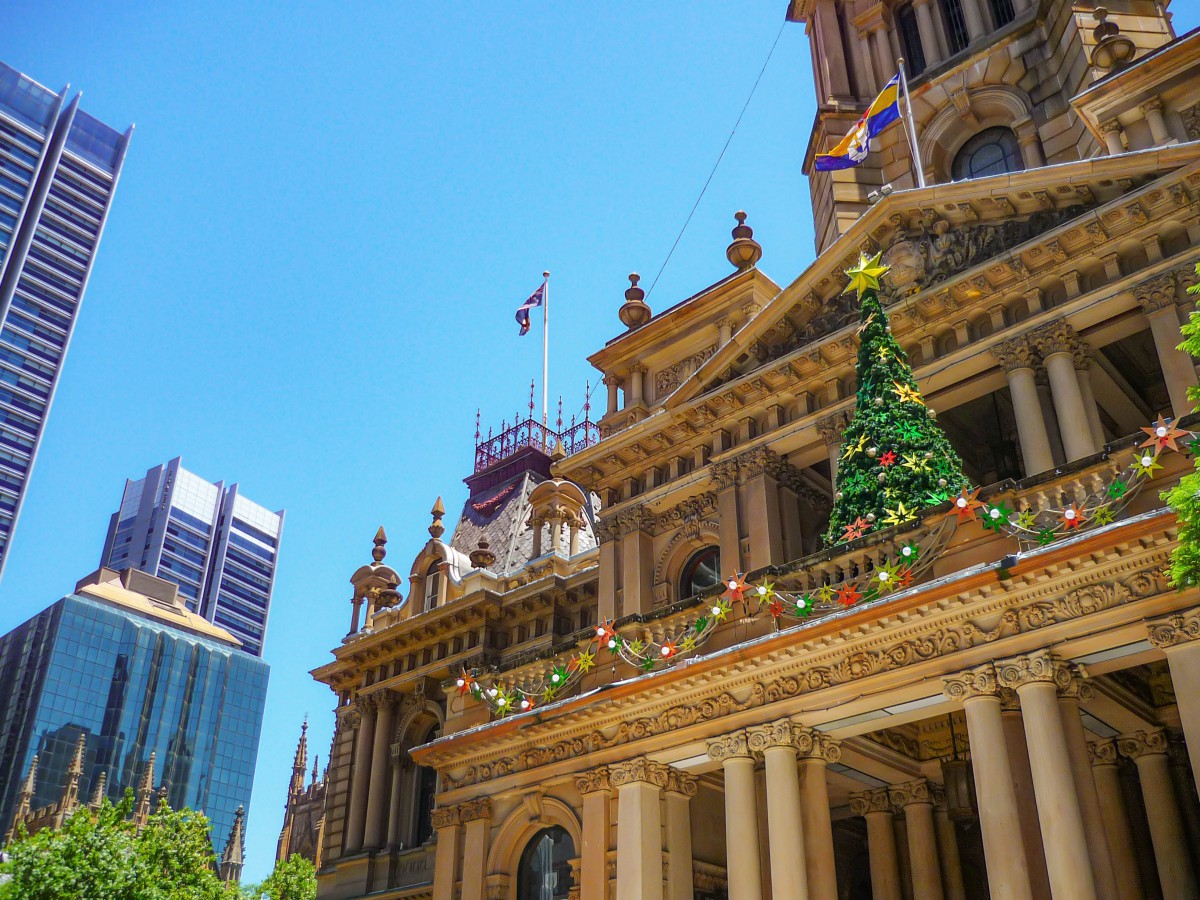
If the clock tower is definitely of Victorian Second Empire style, the City Hall of Paris directly inspired the fanciful mansard roofs.
Look at the roof-scape. It is ornate with slate-covered mansard pavilions. It shows wrought iron cresting and finials, louvred dormers and decorative metal festoons.
And then, there is this rectangular dome (Tuileries-style) on both sides of the building:
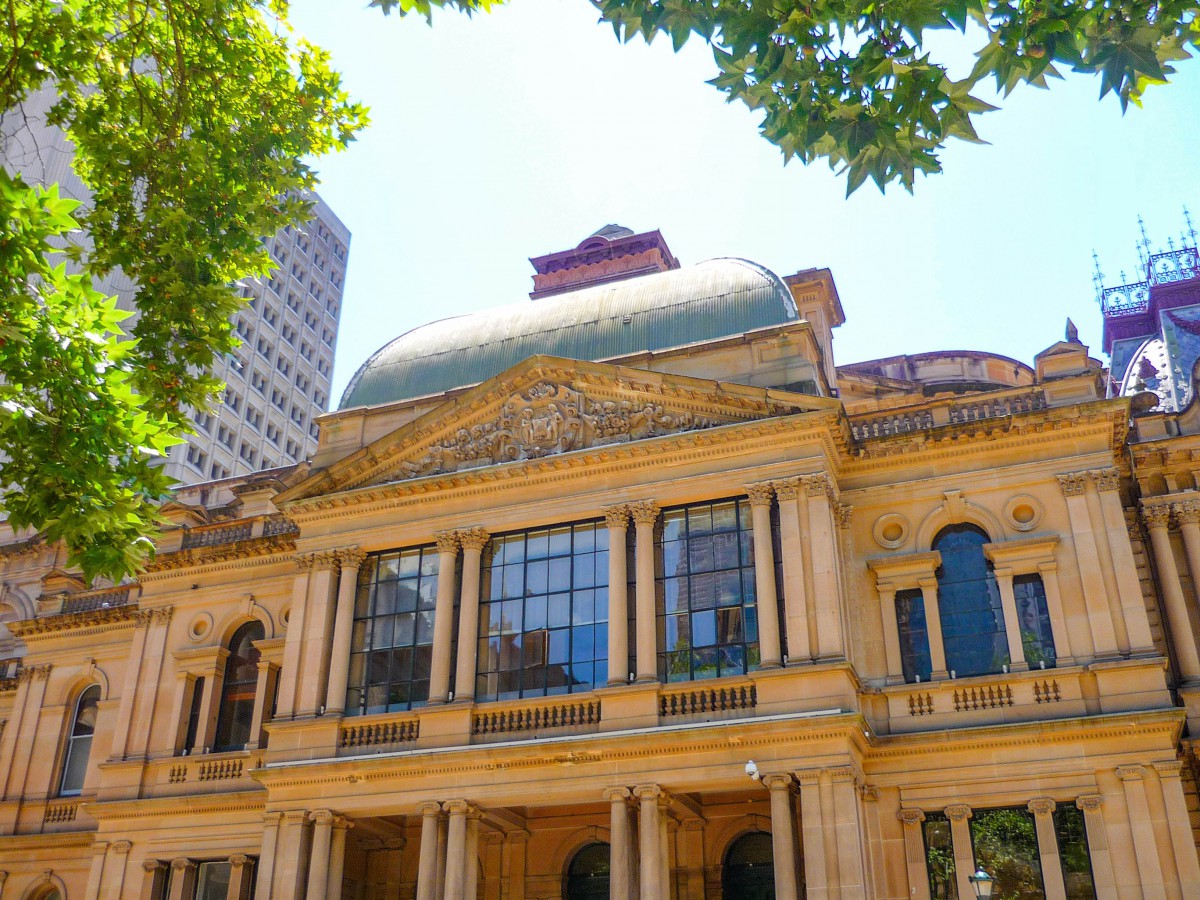
All that to say that strikingly the Sydney Town-Hall is the finest example of French Second Empire architecture in Australia.
Although the Tuileries disappeared some 150 years ago, it still resonates in many heritage-listed buildings across the world!
What do you think? Should Paris rebuild the Tuileries Palace? Tell me more by commenting below!
Get more info about the Palais des Tuileries
- The article on Wikipedia
- The official website of the National Committee for the Reconstruction of the Tuileries
- Reconstruisons les Tuileries! (a facebook page)




Great article, Pierre. Buona Domenica!
Cheers!! Bon dimanche ! 🙂
Paris has such an abundance of grand buildings that one more addition historic as it may be surely would not justify the enormous building cost.
Actually the cost of rebuilding the Tuileries would be much less expensive than restoring Notre-Dame… and partisans of its reconstruction claim that it would create more jobs and provide a larger exhibition space for the Louvre. However it’s very unlikely that the palace will be rebuilt in the decades to come…
Thank you for this great article! It was a pleasure to read. The reconstruction of the Tuileries Palace would be something I would love to see happen in my lifetime. It was such a shame that the palace got demolished, even though it could have been conserved and built again in the future for much less effort than now, when there is nothing left of the foundation. Hopefully we will see the palace built again in the future!
Thank you Greta for your comment! This reconstruction is a bet on the future!!